Clean water solutions for low- and middle-income countries don’t have to be expensive, but they have to be available. The statistics are sad: 1.7 billion people use a drinking water source contaminated with feces, and more than 500,000 people die of waterborne disease each year, most of them younger than 5 years old.
Clean water straight from the tap is as good as it gets. But until everyone has gold-standard infrastructure, there are lower cost solutions available. Boiling water over a wood fire is one of the most widely used methods in low- and middle-income countries, but it is also a health hazard for those working in poorly ventilated kitchens. Cooking fires also exacerbate deforestation. Instead, we’ve rounded up ten low-cost technologies to treat water, and not one requires boiling. Most of these are for household use, but a few are for community-wide treatment.
Do you know of other methods? Please let us know in a comment below.
Ceramic Filters
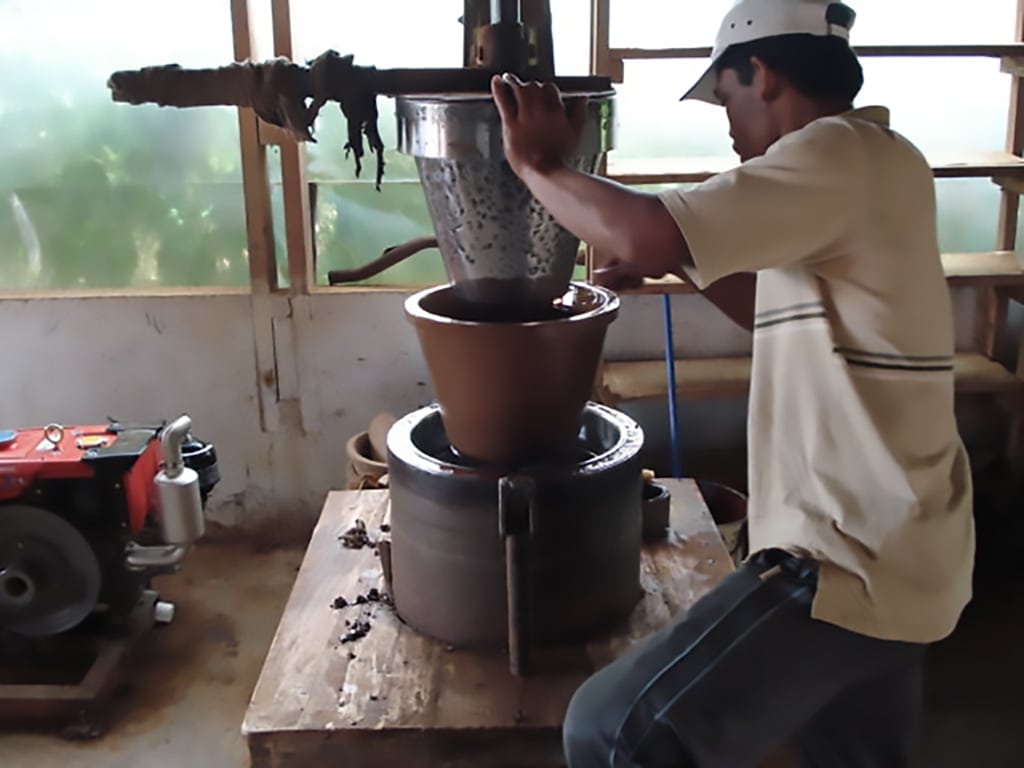
A filter maker presses clay in a hydraulic press in Indonesia. Photo courtesy of Pelita Indonesia
Clay, sawdust and a plastic bucket can make a water filter that catches dirt and disease-causing microbes. In the classic design, mix clay with a combustible material like sawdust or rice husks, give it a flower pot shape and fire it in a kiln. The sawdust or rice husks burn away, leaving tiny pores in the ceramic through which water filters.
Potters for Peace promotes an open source system called CT Filtron, distributed in Ghana, that treats water with silver-enhanced ceramic filtration. CT Filtron is one of 25 ceramic filters archived for comparison in our Solutions Library.
Bamboo Charcoal
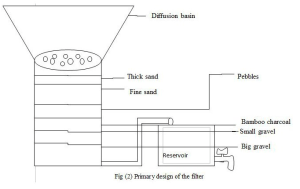 In this spin on the charcoal filter, a team of E4C members in Bangalore propose a filter made of locally available materials including charred bamboo, gravel and natural adsorbents. “The process we propose is indigenous, eco-friendly, low cost and entails minimum maintenance,” the team wrote in a message to E4C. They estimate that their filter can handle 30 liters of water per hour, and it would be affordable for average households in the region.
In this spin on the charcoal filter, a team of E4C members in Bangalore propose a filter made of locally available materials including charred bamboo, gravel and natural adsorbents. “The process we propose is indigenous, eco-friendly, low cost and entails minimum maintenance,” the team wrote in a message to E4C. They estimate that their filter can handle 30 liters of water per hour, and it would be affordable for average households in the region.
Solar Disinfection (SODIS)
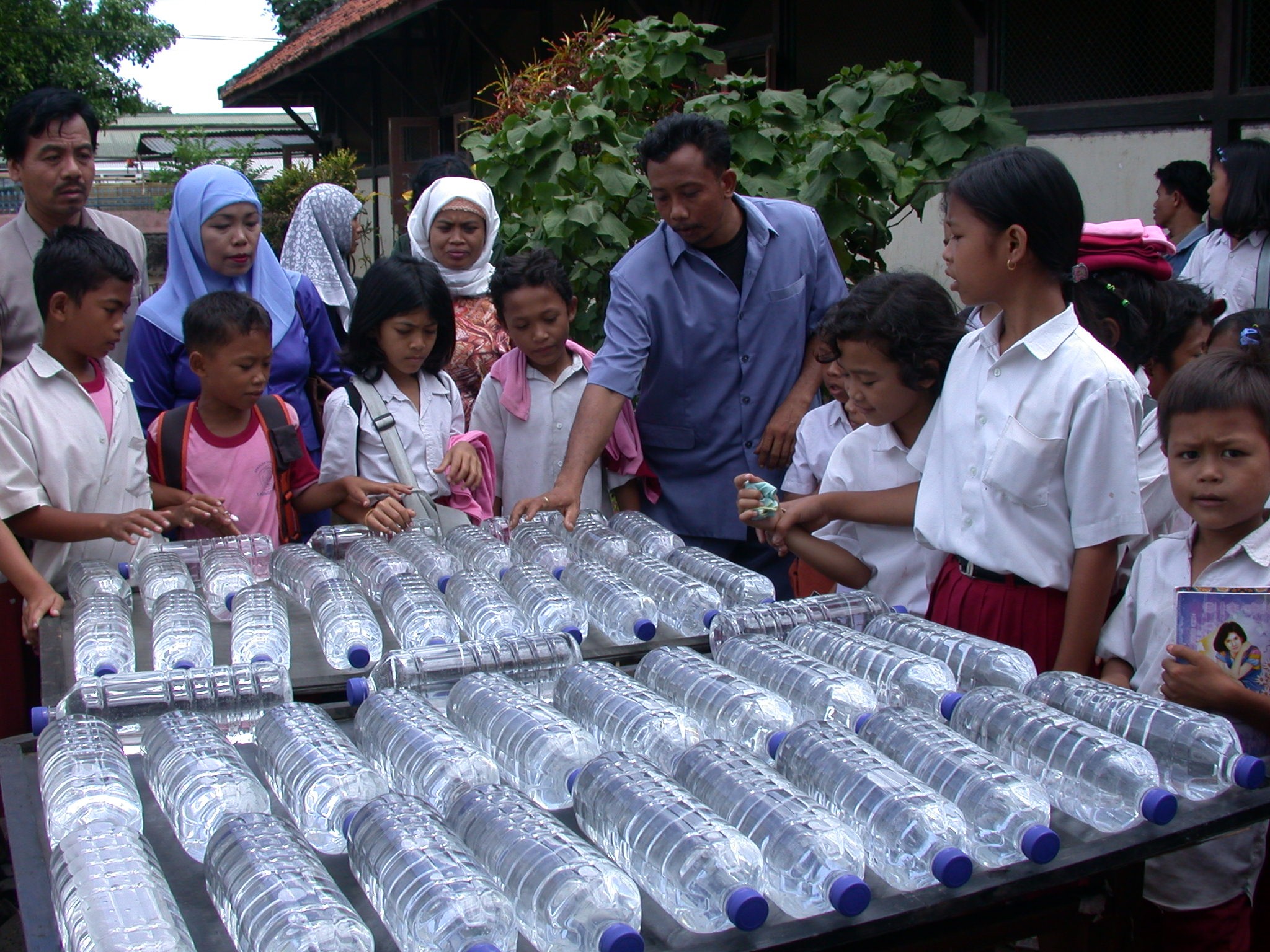
Clear PET plastic bottles of water disinfect in the sunlight in a community in Indonesia. SODIS Eawag (CC by 3.0)
If cost is a bigger concern than time or convenience, the cheapest way to treat water is to leave it in a plastic bottle in the sunlight. Leave clear bottles in the sun for a few hours and UV radiation and heat kills the microbes that cause diarrhea and other waterborne illness. The Sodis (for solar disinfection) method was deployed in some parts of Haiti after the earthquake in 2010, and it is used in emergencies and impoverished regions worldwide.
“It is the combined effect of UV irradiation and high temperature that leads to antimicrobial action,” according to a paper published in 2020 in the journal ACS Catalysis.
WADI Solar Disinfection Indicator
Solar disinfection is one of the cheapest ways to kill microbes in water, but it is possible to make mistakes. Clouds, shade and the placement of the bottles and the murkiness of the water can change the amount of time needed to disinfect. To take solar disinfection to the next level and remove the guesswork, try WADI. WADI, by Helioz, is a device that measures solar radiation levels to indicate when the water is sterilized. Just look for the happy smiley face on WADI’s display.
Yet there may be room for competing designs in this category: we came across this prototype of a solar indicator at IEEE’s Global Humanitarian Technology Conference in Seattle, Washington (USA).
Portable Solar Distiller
Not to be confused with solar sterilization or disinfection, solar distillation purifies even muddy, salty or otherwise undrinkable water through evaporation and condensation. The power of distillation to purify saltwater makes it unique among the treatment methods featured on this page.
A solar still can actually be a cheap and simple piece of shaped plastic or glass, or they can be more highly designed devices such as Henry Glogau’s award-winning portable solar distiller featured in the video above. “The portable design merges local resource production with community architecture, providing freshwater and a shaded gathering place,” according to the video’s description.
To work, the still places water contaminated with salt or other impurities in direct sunlight where it heats and evaporates. The water vapor is trapped and condenses into droplets that run off into a container. This simple process takes huge amounts of energy, which is why solar stills can make more sense than stills powered by other fuels.
For another take on the solar still, see the Eliodomestico terracota household still in our Solutions Library.
Bicycle-Powered Water Filter
Bicycles in all their glorious versatility and simplicity are a favorite at E4C, and we were pleased to find a small but thriving supply of bicycle water filter videos, including this one by mechanical engineering students at the University of Maine. The Clean Water Team developed the bike-powered filter, and their project page describes the build, including a bill of materials.
For more bicycle action, see our list of ten things you can do with a bicycle.
Emergency Homemade Filter
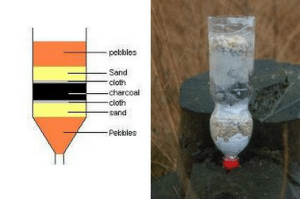 The plastic bottle makes yet another appearance as a water treatment device, this time as a simple filter that can remove sediment and even disease-causing microbes. Simply cut the bottom from the bottle, fill it with layers of gravel, sand cloth and charcoal, filter the water through it and hope for the best.
The plastic bottle makes yet another appearance as a water treatment device, this time as a simple filter that can remove sediment and even disease-causing microbes. Simply cut the bottom from the bottle, fill it with layers of gravel, sand cloth and charcoal, filter the water through it and hope for the best.
Slow Sand Filtration
Slow sand filtration has the advantage of working on an entire community’s water source, not just individual households. West Virginia University offers a technical brief on slow sand filtration systems, including a design summary.
A slow sand filtration system is a combination of several parts: water storage tanks, an aerator, pre-filters, sand filters, disinfection stages, and filtered water storage tanks. The number of filters and filter types that are used in a given slow sand filtration system will depend on the quality of the source water and will be different for each community.
WATA Sodium Hypochlorite System
Chlorine is one of the most versatile and effective clean water solutions in LMICs and everywhere else. Chlorine can work in a community water supply to kill microbes before it enters people’s jerry cans or home water supplies. And it keeps the water safe from new contaminations long after it is added.
Community-wide water treatment with chlorine is now possible using only water, salt, electricity and a portable device called WATA. The system converts a measure of salt and water into sodium hypochlorite (bleach) by the process of electrolysis, passing an electric current through the saline soluiton. Designed by the Antenna Foundation in Geneva, Switzerland, WATA produces enough chlorine in two hours to treat 2,500 liters of water. The product has been tested for more than 10 years, it is commercially available and comes in five sizes depending upon the quantity of active chlorine desired (from 0.5 liters to 60 liters).
Aguaclara Reach Water Treatment Plant
The AguaClara Reach Full Scale Plant is a compact gravity-fed water treatment system that uses a five-step process to treat and filter water. The system adds a coagulant to the water to settle out sediment and other particles, then runs the water through a sand filter and adds chlorine before storing it.
This community treatment plant can serve 1,000 to 50,000 people.
E4C’s Solutions Library
Please see E4C’s Solutions Library for more clean water solutions suitable for communities in low- and middle-income countries. In our database you can view standardized information about hundreds of products and compare similar technologies side by side.
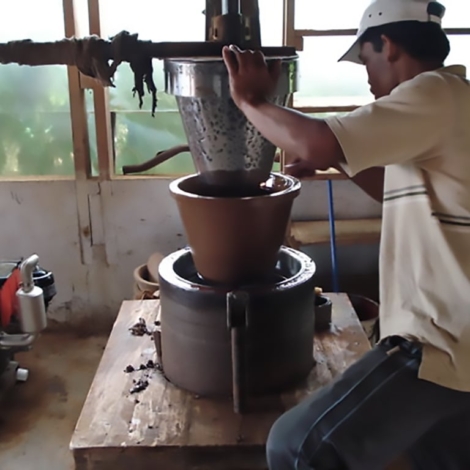
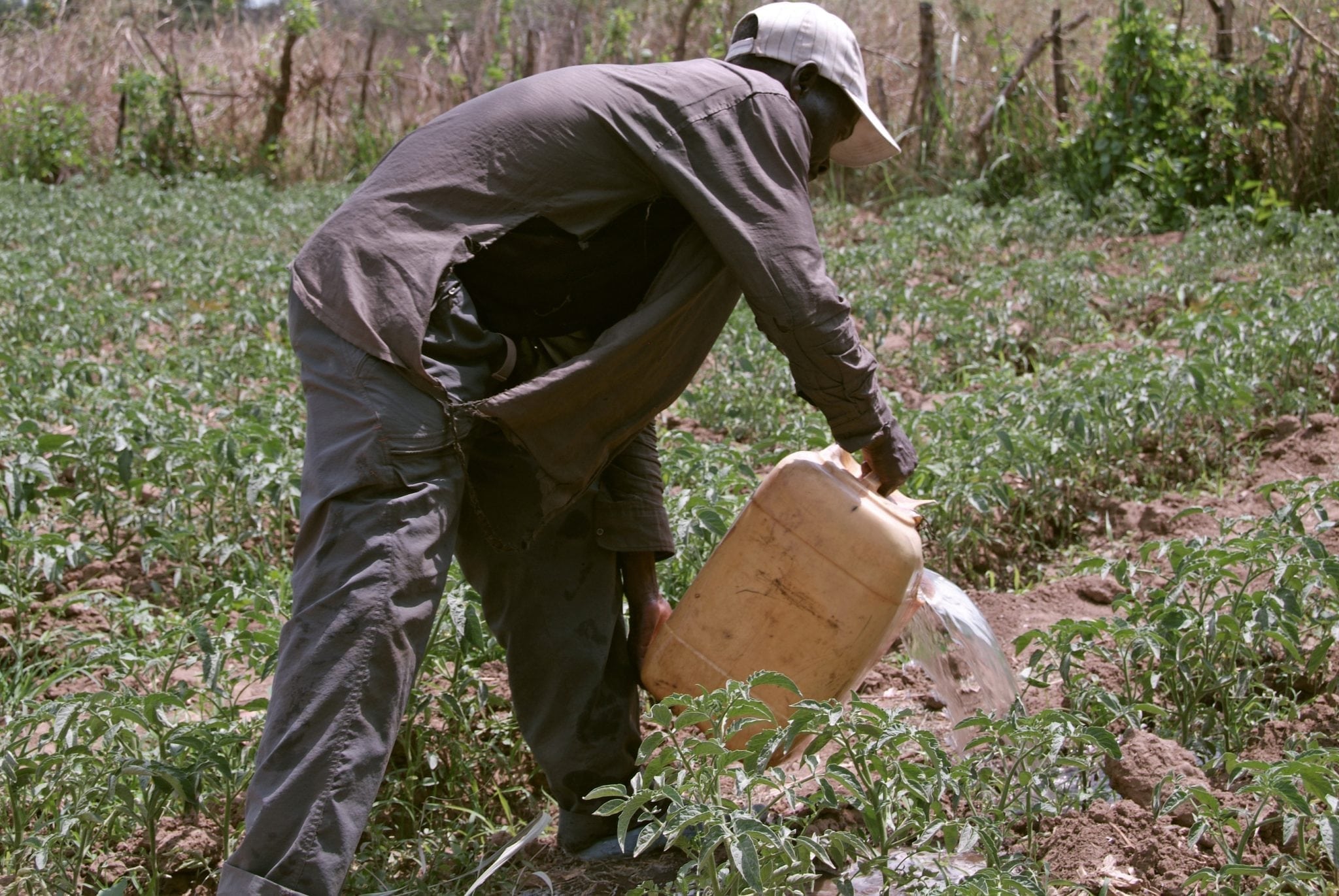
THANK YOU FOR THIS CONVINIENT INCLUSION OF THESE IDEAS TO TREAT WASTE WATER. PLEASE ADD LINKS TO ALL THESE METHODS’ DESCRIPTION. A VIDEO WILL HELP SERVE EVEN BETTER.
You did not tell how to treat chlorine water. Why???
Chlorine is considered a method of treating water! Our goal was to treat water by removing life-threatening pathogens. But chlorine can be a problem, too. The bad taste it leaves can deter people from using it. If you know of effective, low-cost ways to remove it please share.
I want water filter plant pls give me details
i sometime think in Indonesia whereas agro is essential but recently no many engineer involve in water treatment for low cost farm. to increase yield in farming one essential is to get better water because many river now are containing some effluent from factories around them and finally teh water consume also for human, farm etc.
i need to discuss with some engineer overseas, how to get technologies go deeply in water treatment for farm especially for low cost farmer.
my background education in chemical engineering and now working fro agrochemical business.
I’M THINKING OF BUILDING MY OWN BONE CHAR FILTER TO FILL A STOCK TANK FOR ICE BATHS. tHAT WILL REMOVE QUITE A BIT OF THE CHEMICALS i’D LIKE TO FILTER. i’VE FOUND SOME FILTERS THAT ALLOW YOU TO PUT BONE CHAR AND ALUMINA SILICATE FOR ADDED FILTRATION AND THE BEST PART THEY ARE REFILLABLE WITH BULK MEDIA.
bUT i HAVE AN ISSUE i WONDER IF SOMEONE CAN CHIME IN ON. THAT WATER IN THE 100 GALLON STOCK TANK. i CAN’T IMAGINE IT CAN SIT LONG BEFORE GROWING SOMETHING. wITH THE CHLORINE FILTERED OUT. Is it possible to add chlorine directly to the water and then remove the chlorine when I am going to use it.
PARDON the caps. It wouldn’t let me type in lowercase.
I need to know the jobs to done on backwash and rinse methods
such a informative and b
etter techniques u provided
105/286 C,Sri nagar Opp Kesco & Police Station Chan Gunj Kanpur
Thank you for mentioning that just by using a bucket, clay, and sawdust, you can actually filter out dirt and other microbes. My husband and I have been wondering whether we should get our water treated and if so how. Though your ceramic filter can catch disease-causing microbes easily, we will probably be asking professional to treat our water so we don’t have any sort of harmful things in there.
well, a lot has been done but more also should be done especially in developing countries where most people are poor and ignorant. am developing a solar water treatment system which could be affordadable to most ugandans who are facing a problem of waterborne diseases
thank you so much.very useful information.
Really appreciated the low cost water filtration overview. I think this can become a passion of mine with certain addition I can see a business which has global applications.
Serve people’s is service of God
Why not a simple hyrdocyclone? Cyclones for removing dust from air are amazingly efficient, and I pelieve there is a way to simply swirl water to remove sand, grit, slurry, etc. There has to be a way to do this.
Very nice information. Thanks
what is the most recommended filter?
Want to read more articles and if agree want to send an article about foot opeta
Engineering for change!
Every time &good to see you
Very useful intermediate technology for developing con
Good to all ideas low cost filter system are the solution to face the climate change.
E17 – SIMPLE WATER TREATMENT METHODS FOR USE IN THE HOME
1) What is involved ?
The methods presented in this factsheet are used to make water drinkable. They can be applied at hole, at the family level.
The methods described comprise :
* Straining
* The three pot method
* Treatment by boiling
* Treatment by chlorination
* Treatment by ceramic filtersLifestraw method
* Treatment by slow sand filtration
* The Naiade method (UV radiation)
* SODIS method (Sun radiation)
* Solvatten method (Sun radiation)
* Lifestraw method
2) Why ?
Treating drinking water prior to consumption combats many illnesses such as dysentery, typhoid fever and cholera.
Illustration Red Cross
3) Straining water through cloth
It is easy to filter water using cloth. This kind of filtration will eliminate the main solid impurities from water as well as any insect larvae that it may contain. The cloth used, cotton preferably, must be thick enough to properly retain the impurities. If it is too thick, then filtration will take longer. It must always be washed prior to use.
Straining alone is not a sufficient form of treatment. Nevertheless, straining water before treating it using one of the other methods described in this factsheet will significantly improve the quality of the water obtained.
a) Advantages
– Simple to use
– Almost no cost
– Very useful, or even essential for pre-treatment purposes
b) Drawbacks
– A summary treatment that cannot make water drinkable if already contaminated
– Cost may be high depending on the energy source used
4) The three pot method
This method serves the same purpose as filtration by removing the main solid impurities found in water.
For improved efficiency, this method may be used to complement filtration.
Source : Household water treatment and safe storage in emergencies, International Red Cross Agrandir
a) Advantages
– Easy to use. Almost no cost.
– Significantly reduces impurities and pathogens
b) Drawbacks
– Disinfection is not complete
– Wait time
5) Treatment by boiling
Boiling too is relatively easy to do. It will kill all of the germs and micro-organisms present in the water. To do so, first filter or decant the water, then bring it to a rolling, bubbling boil (simply steaming water is not boiled) for one minute at low altitude and for at least three minutes at altitudes above 2,000 metres. Boiled water may lack taste. This problem can be solved by vigorously shaking the water purified to re-oxygenise it or by adding a little salt.
a) Advantages
– Easy to use
– Kills all pathogens
b) Drawbacks
– Required wood (approx. 1 kg per litre of water) and a heat resistant recipient
– Actual cost is relatively high
6) Treatment by chloration
(For more information, refer to Factsheet E 18 “Treatment by Chlorination”.)
Chlorination is a simple and effective way to disinfect water to make it drinkable. It comprises introducing chlorinated products (chlorine tabs, bleach, etc.) into the water to kill the micro-organisms contained in it. After the products have acted for 30 minutes, the water will be drinkable. It remains so for a few days (depending on storage conditions) thanks to the non volatility of the chlorine.
a) Advantages
– Muddy water can be made drinkable. If the treatment is done properly, all of the pathogens are eliminated.
– Chlorination has a durable effect.
b) Drawbacks
– Products must, for the most part, be brought in from elsewhere. Handling risks involved.
– Non negligible cost.
Chlorination may, for example, take place after flocculation, where necessary in an earthenware pot fitted with a tap on the bottom (The drinking water station dreamt up by Dr Monjour, see end) or in any other recipient.
Good article, have you ever looked at the ‘Watercone’ and if yes, what is the opinion about this technology? Why is it not broadly in use because it looks very promising invention.
That looks interesting, thanks for mentioning it. I’ve forwarded your comments on to the Solutions Library manager for possible inclusion.
I rather say that you have done remarkable research but some aspect of the diagram of water treatment needs some tweaking for getting more efficiency